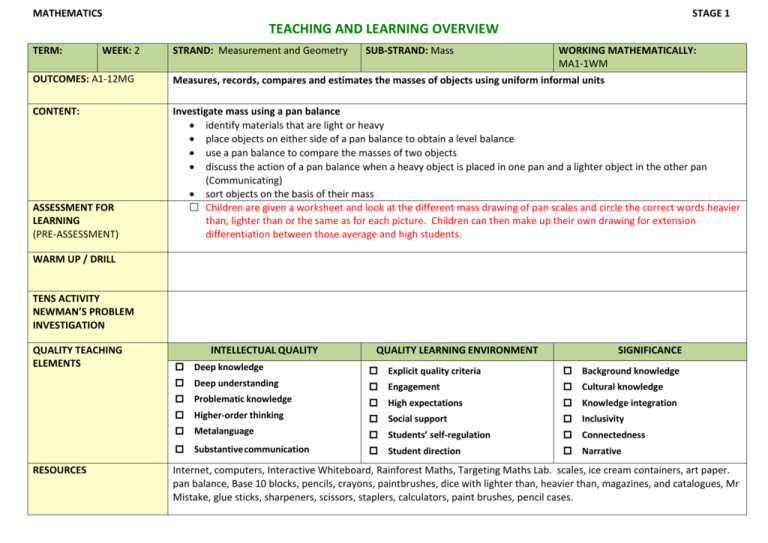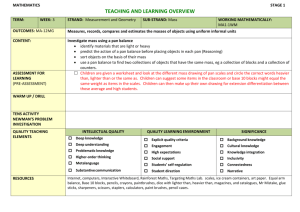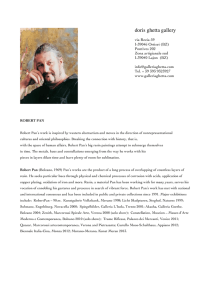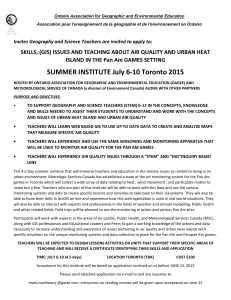MASS - Stage 1
advertisement

MATHEMATICS STAGE 1 TEACHING AND LEARNING OVERVIEW TERM: WEEK: 2 OUTCOMES: A1-12MG CONTENT: ASSESSMENT FOR LEARNING (PRE-ASSESSMENT) STRAND: Measurement and Geometry SUB-STRAND: Mass WORKING MATHEMATICALLY: MA1-1WM Measures, records, compares and estimates the masses of objects using uniform informal units Investigate mass using a pan balance identify materials that are light or heavy place objects on either side of a pan balance to obtain a level balance use a pan balance to compare the masses of two objects discuss the action of a pan balance when a heavy object is placed in one pan and a lighter object in the other pan (Communicating) sort objects on the basis of their mass Children are given a worksheet and look at the different mass drawing of pan scales and circle the correct words heavier than, lighter than or the same as for each picture. Children can then make up their own drawing for extension differentiation between those average and high students. WARM UP / DRILL TENS ACTIVITY NEWMAN’S PROBLEM INVESTIGATION QUALITY TEACHING ELEMENTS RESOURCES INTELLECTUAL QUALITY QUALITY LEARNING ENVIRONMENT SIGNIFICANCE Deep knowledge Explicit quality criteria Background knowledge Deep understanding Engagement Cultural knowledge Problematic knowledge High expectations Knowledge integration Higher-order thinking Social support Inclusivity Metalanguage Students’ self-regulation Connectedness Substantive communication Student direction Narrative Internet, computers, Interactive Whiteboard, Rainforest Maths, Targeting Maths Lab. scales, ice cream containers, art paper. pan balance, Base 10 blocks, pencils, crayons, paintbrushes, dice with lighter than, heavier than, magazines, and catalogues, Mr Mistake, glue sticks, sharpeners, scissors, staplers, calculators, paint brushes, pencil cases. TEACHING AND LEARNING EXPERIENCES WHOLE CLASS INSTRUCTION MODELLED ACTIVITIES Lesson Comparing Mass using pan balance. The teacher introduces pan balance/scales to the students. Explain how the scales work, the heavier item will sit lower and the lighter item will sit higher. The teacher puts 3 tens blocks in one side. How many tens blocks do I need to put into the other pan to make the pans balance? Try the student’s suggestions. GUIDED & INDEPENDENT ACTIVITIES LEARNING SEQUENCE Remediation ES1 LEARNING SEQUENCE S1 How many tens blocks do I need to put in the other pan to make this side heavier/lighter? Try the suggestions. LEARNING SEQUENCE This can be done with any items you can find in the classroom Extension Early S2 Lesson: Gather up a collection of classroom objects, whatever you have in your classroom is fine. The students will guess which objects will be heavy and which objects will be light in comparison to each other. The students than use scales to work out which object were heavier or lighter or equal to the other item. They can record this on a worksheet or in their books by writing heavier or lighter or equal Put 3 tens blocks in one side of the balance. Children suggest something that would be lighter/heavier/the same. Try the suggestions. Language Mass, heavy, light, hefting, heavier, equal, same, lighter, pan balance, scales In a small group children are given two objects to heft. Each child keeps the heavy of their two objects. Children then heft all the heaviest objects and order them from heaviest to lightest. Results are recorded on a worksheet or in a workbook. EVALUATION & REFLECTION Students can record their findings on the computer, Microsoft word or kid pix programs. Equal Masses: Choose an object. Students collect things from around the room that might combine to have the same mass as an object, eg. The duster has the same mass as three pencils and four rubbers. Repeat activity many times, measuring the mass of different objects Did the students enjoy the activity? Were the outcomes achieved? Where to next? All assessment tasks should be written in red and planning should be based around developing the skills to complete that task. Assessment rubrics or marking scale should be considered.






